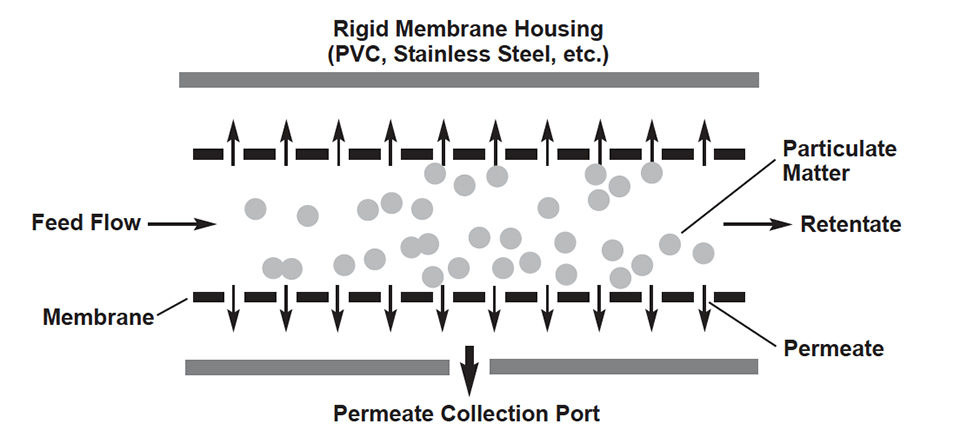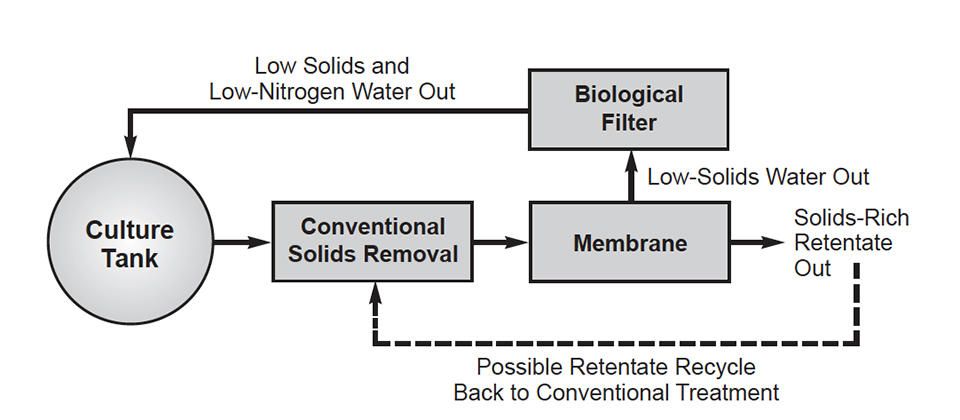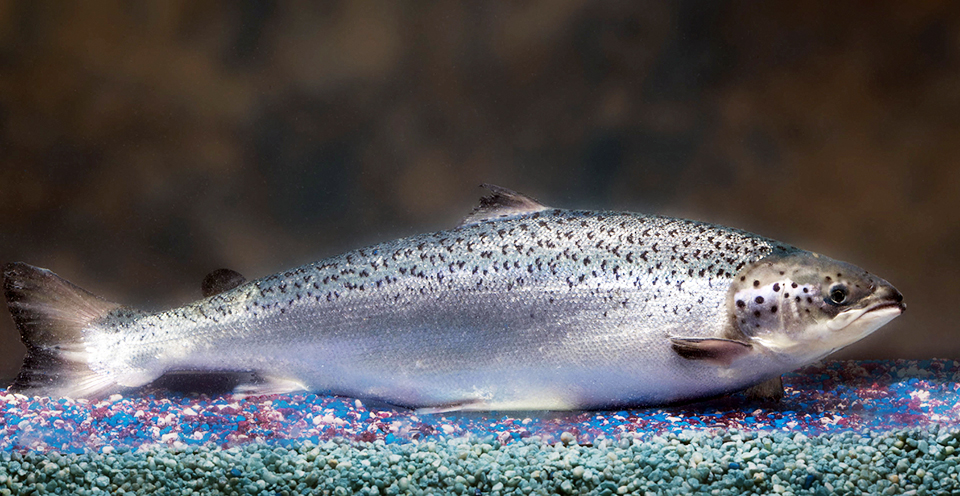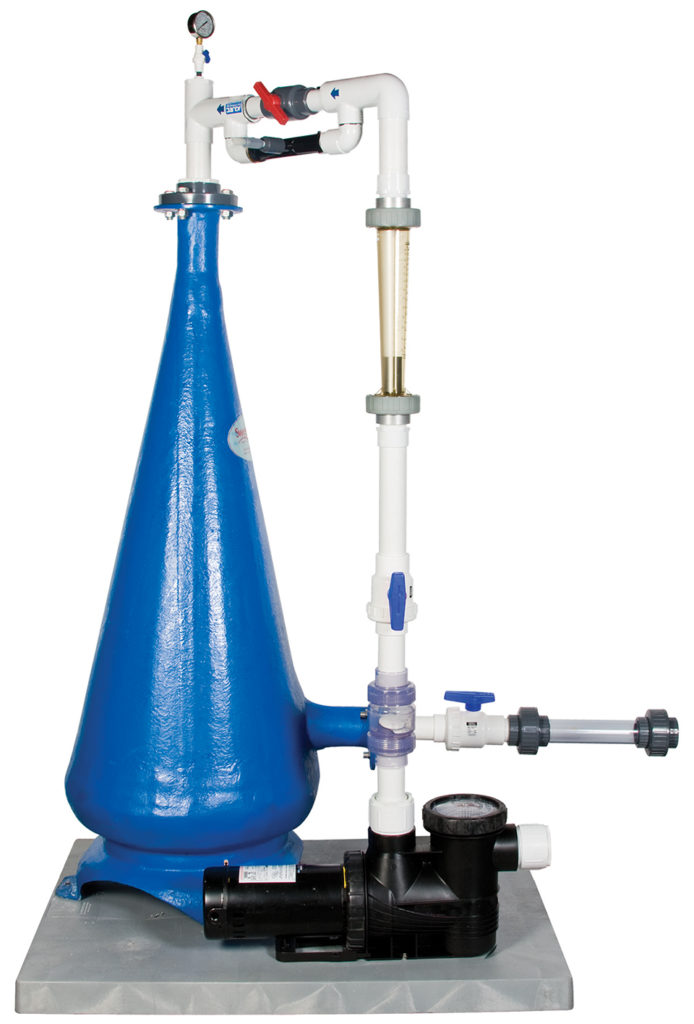Recirculating aquaculture systems (RASes) are being widely adopted as sustainable platforms to meet the increasing worldwide demand for fish and seafood products. However, the efficient operation of RASes is contingent upon the constant conditioning of process water to manage biosolids formed in the culture tanks, remove toxic dissolved constituents such as ammonia, and maintain suitable dissolved- oxygen concentrations. Generally, as recycled water is continually reused, the treatment processes required to recondition RAS process water becomes increasingly complex.
Managing solids
In RAS, the accumulation of organic solids decreases the amount of dissolved oxygen available for fish respiration and is thus a major factor that limits the density of fish that can be raised. Organic solids are also known to serve as host sites for opportunistic pathogens, which can have further adverse effects on RAS productivity.
Conventional treatment processes such as gravity settling and microscreen clarification are effective at removing large solids from RAS process water. However, fine organic solids with diameters less than 20 to 25 μ often escape conventional treatment and accumulate over time.
One emerging method for managing the build-up of fine solids in RAS process water is pressure-driven membrane separation. In this method, particulate matter larger than the membrane pores is blocked, while water and dissolved constituents pass freely through the membrane.
Sources, effects of suspended solids
Solid wastes in RASes are generated directly or indirectly from the feed added to the system. They are present as uneaten feed residuals, fish metabolites, manure, and/or microorganisms that grow in the system.
For instance, appreciable fractions of total nitrogen are associated with organic particles. Further, direct links exist between organic solid loading and bacterial gill disease and amoebae gill infestation. Consequently, effective solids-management measures are necessary for efficient RAS operation.
RAS operations And microfiltration
In typical RAS treatment, culture tank effluent generally passes through a solids-removal process, such as gravity settling, microscreen clarification, rotary drum filtration, or rotary disc screening in which a wide range of screen mesh sizes (60 to 200 μ) are applied. Solids removal processes are then typically followed by an attached growth biofilter to remove dissolved nitrogen. However, fine particulate matter of 20 to 25 μ diameter is not effectively removed in conventional treatment processes, accumulates, and thus leads to a deterioration of water quality.
Microfiltration is a pressure-driven separation technology in which a semipermeable membrane is used to selectively retain particles with diameters in excess of 0.05 to 10 μ, while allowing smaller constituents, including water and dissolved components, to pass freely through the membrane. Typically, microfiltration systems are operated in “cross-flow” mode, as presented in Fig. 1.

In cross-flow filtration, the feed solution (process water containing fine solids) is passed parallel to the membrane surface, and two streams leave the module: permeate (solids-free water) and retentate (concentrated solids). The major advantage of cross-flow filtration is a reduction in build-up of solids on the membrane surface, which reduces the clogging of membrane pores.
In general, under conditions of low waste concentration and high hydraulic turbulence, the volume rate of clean water production per unit membrane area, known as the “permeate flux,” is proportional to the driving force, transmembrane pressure. However, as solids build up on the membrane surface, flux becomes independent of transmembrane pressure due to the formation of a concentration boundary layer at the membrane surface.
Microfiltration in RASes
Treatment performance
The prediction of microfiltration system performance is highly dependent on the physical and chemical characteristics of the feed solution, and the selection of operating conditions, such as transmembrane pressure, crossflow velocity, etc. Consequently, pilot scale studies are needed to tailor operating conditions to particular feed streams.
Viadero and Noblet’s 2002 report on the application of microfiltration to synthetic RAS process water found that a membrane with 0.05-μ pore sizewas suited to the removal of fine particles over a transmembrane pressure range of 28 to 179 kPa (4-26 psi). Permeate flux was found to increase with RAS process water temperature.
The flux increase was attributed to a decrease in permeate (water) viscosity with increase in temperature. Permeate also increased with transmembrane pressure up to a limiting point. Pressure-independent permeate flux was found higher for cases in which higher cross-flow velocity was employed.
This observation was attributed to the more effective scouring of accumulated particles from the membrane surface under conditions of higher turbulence. While high solids and biochemical oxygen demand removals were observed, the removal efficiencies of dissolved solids, total nitrogen, and total phosphorous were poor, since the pores of microfiltration membranes are not small enough to retain dissolved species.
Process implementation
Based on economic considerations, microfiltration cannot compete against other technologies such as rotary microscreen filters for the direct treatment of RAS process water. However, since other conventional treatment processes are effective at clarifying large quantities of water, but are not able to remove fine particulate matter, an opportunity exists to incorporate membrane filtration as an additional “polishing step” to control the buildup of fine solids in RASes, as presented in Fig. 2.

In such a strategy, removal of large particulate matter would be affected by conventional processes. Then, small solids would be removed using membrane filtration. This arrangement would reduce oxygen demand associated with coarse and fine organic matter, while decreasing the opportunity for the accumulation of pathogenic organisms in recirculating systems. Further, through the more efficient removal of both coarse and fine solids, loading to the biofilter can be reduced, resulting in further process enhancement.
Conclusion
While membrane filtration is not a cost-effective alternative to coarse solids removal processes such as microscreen clarification, membrane filtration for the removal of fine solids has potential niche applications. These include larval fish culture and the rearing of high-value products, which have yet to be explored.
Note: This article was adapted from “Membrane Filtration for Removal of Fine Solids from Aquaculture Process Water,” an article by the author and James A. Noblet that appeared in the August 2002 Aquacultural Engineering.
(Editor’s Note: This article was originally published in the June 2003 print edition of the Global Aquaculture Advocate.)
Now that you've reached the end of the article ...
… please consider supporting GSA’s mission to advance responsible seafood practices through education, advocacy and third-party assurances. The Advocate aims to document the evolution of responsible seafood practices and share the expansive knowledge of our vast network of contributors.
By becoming a Global Seafood Alliance member, you’re ensuring that all of the pre-competitive work we do through member benefits, resources and events can continue. Individual membership costs just $50 a year.
Not a GSA member? Join us.
Author
-
Roger C. Viadero, Jr., Ph.D.
West Virginia University
Department of Civil and Environmental Engineering
P.O. Box 6103
Morgantown, West Virginia
26506-6103 USA
Tagged With
Related Posts

Intelligence
10 takeaways from GOAL 2019 in Chennai, India
The Global Aquaculture Alliance held its GOAL conference in Chennai, India, and recruited a host of experts in various fields to share their expertise.

Intelligence
A brief look at genetically modified salmon
If approved by FDA, fast-growing genetically modified salmon will provide a safe and nutritious product similar to other farmed Atlantic salmon.

Responsibility
A look at unit processes in RAS systems
The ability to maintain adequate oxygen levels can be a limiting factor in carrying capacities for RAS. The amount of oxygen required is largely dictated by the feed rate and length of time waste solids remain within the systems.

Responsibility
A look at various intensive shrimp farming systems in Asia
The impact of diseases led some Asian shrimp farming countries to develop biofloc and recirculation aquaculture system (RAS) production technologies. Treating incoming water for culture operations and wastewater treatment are biosecurity measures for disease prevention and control.


